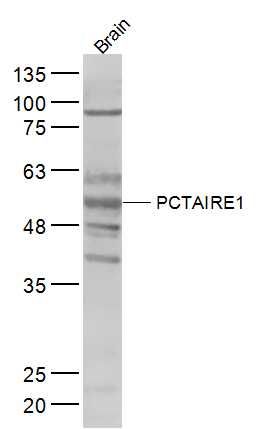PCTAIRE1 Polyclonal Antibody
Purified Rabbit Polyclonal Antibody (Pab)
- SPECIFICATION
- CITATIONS
- PROTOCOLS
- BACKGROUND

Application
| WB, IHC-P, IHC-F, IF, ICC, E |
|---|---|
| Primary Accession | Q00536 |
| Reactivity | Rat, Pig, Dog, Bovine |
| Host | Rabbit |
| Clonality | Polyclonal |
| Calculated MW | 56 KDa |
| Physical State | Liquid |
| Immunogen | KLH conjugated synthetic peptide derived from human PCTAIRE1 |
| Epitope Specificity | 61-160/496 |
| Isotype | IgG |
| Purity | affinity purified by Protein A |
| Buffer | 0.01M TBS (pH7.4) with 1% BSA, 0.02% Proclin300 and 50% Glycerol. |
| SUBCELLULAR LOCATION | Cytoplasm. Cytoplasmic vesicle, secretory vesicle. Cell membrane; Peripheral membrane protein; Cytoplasmic side.Cell junction, synapse, synaptosome |
| SIMILARITY | Belongs to the protein kinase superfamily. CMGC Ser/Thr protein kinase family. CDC2/CDKX subfamily. Contains 1 protein kinase domain. |
| SUBUNIT | Found in a complex containing CABLES1, CDK17 and TDRD7. Interacts with YWHAH, YWHAQ and YWHAZ. Interacts with NSF.Identified in a complex with NSF, syntaxin-1, synaptotagmin, SYN1,SYP and CDK5R1 (By similarity). Interacts with BRSK2. Interacts with CCNY; this increases the CDK16 kinase activity. |
| Important Note | This product as supplied is intended for research use only, not for use in human, therapeutic or diagnostic applications. |
| Background Descriptions | The protein encoded by this gene belongs to the cdc2/cdkx subfamily of the ser/thr family of protein kinases. It may play a role in signal transduction cascades in terminally differentiated cells; in exocytosis; and in transport of secretory cargo from the endoplasmic reticulum. This gene is thought to escape X inactivation. Alternative splicing results in multiple transcript variants encoding different isoforms. [provided by RefSeq, Dec 2009] |
| Gene ID | 5127 |
|---|---|
| Other Names | Cyclin-dependent kinase 16, 2.7.11.22, Cell division protein kinase 16, PCTAIRE-motif protein kinase 1, Serine/threonine-protein kinase PCTAIRE-1, CDK16, PCTAIRE1, PCTK1 |
| Dilution | WB=1:500-2000,IHC-P=1:100-500,IHC-F=1:100-500,ICC=1:100-500,IF=1:100-500,ELISA=1:5000-10000 |
| Storage | Store at -20 ℃ for one year. Avoid repeated freeze/thaw cycles. When reconstituted in sterile pH 7.4 0.01M PBS or diluent of antibody the antibody is stable for at least two weeks at 2-4 ℃. |
| Name | CDK16 |
|---|---|
| Synonyms | PCTAIRE1, PCTK1 |
| Function | Protein kinase that plays a role in vesicle-mediated transport processes and exocytosis. Regulates GH1 release by brain neurons. Phosphorylates NSF, and thereby regulates NSF oligomerization. Required for normal spermatogenesis. Regulates neuron differentiation and dendrite development (By similarity). Plays a role in the regulation of insulin secretion in response to changes in blood glucose levels. Can phosphorylate CCNY at 'Ser-336' (in vitro). |
| Cellular Location | Cytoplasm. Cytoplasmic vesicle, secretory vesicle {ECO:0000250|UniProtKB:Q63686} Cell membrane; Peripheral membrane protein; Cytoplasmic side. Synapse, synaptosome {ECO:0000250|UniProtKB:Q63686}. Note=Colocalizes with insulin in pancreas islets. Recruited to the cell membrane by CCNY |
| Tissue Location | Detected in pancreas islets (at protein level). Detected in brain and pancreas. |

Thousands of laboratories across the world have published research that depended on the performance of antibodies from Abcepta to advance their research. Check out links to articles that cite our products in major peer-reviewed journals, organized by research category.
info@abcepta.com, and receive a free "I Love Antibodies" mug.
Provided below are standard protocols that you may find useful for product applications.
If you have used an Abcepta product and would like to share how it has performed, please click on the "Submit Review" button and provide the requested information. Our staff will examine and post your review and contact you if needed.
If you have any additional inquiries please email technical services at tech@abcepta.com.













 Foundational characteristics of cancer include proliferation, angiogenesis, migration, evasion of apoptosis, and cellular immortality. Find key markers for these cellular processes and antibodies to detect them.
Foundational characteristics of cancer include proliferation, angiogenesis, migration, evasion of apoptosis, and cellular immortality. Find key markers for these cellular processes and antibodies to detect them. The SUMOplot™ Analysis Program predicts and scores sumoylation sites in your protein. SUMOylation is a post-translational modification involved in various cellular processes, such as nuclear-cytosolic transport, transcriptional regulation, apoptosis, protein stability, response to stress, and progression through the cell cycle.
The SUMOplot™ Analysis Program predicts and scores sumoylation sites in your protein. SUMOylation is a post-translational modification involved in various cellular processes, such as nuclear-cytosolic transport, transcriptional regulation, apoptosis, protein stability, response to stress, and progression through the cell cycle. The Autophagy Receptor Motif Plotter predicts and scores autophagy receptor binding sites in your protein. Identifying proteins connected to this pathway is critical to understanding the role of autophagy in physiological as well as pathological processes such as development, differentiation, neurodegenerative diseases, stress, infection, and cancer.
The Autophagy Receptor Motif Plotter predicts and scores autophagy receptor binding sites in your protein. Identifying proteins connected to this pathway is critical to understanding the role of autophagy in physiological as well as pathological processes such as development, differentiation, neurodegenerative diseases, stress, infection, and cancer.


